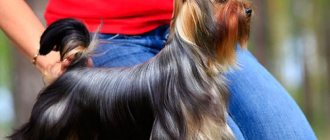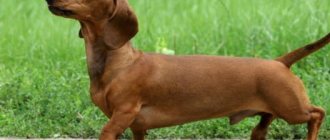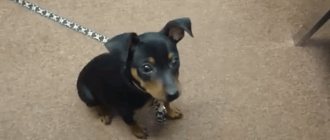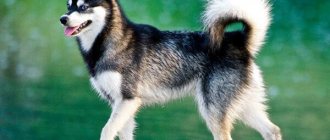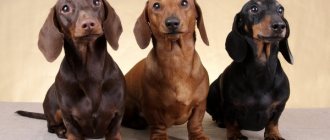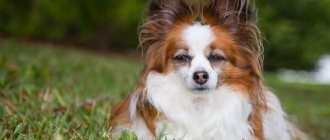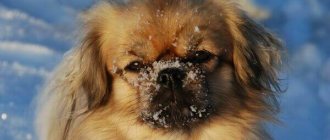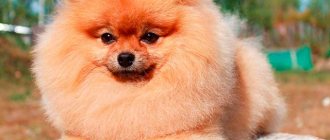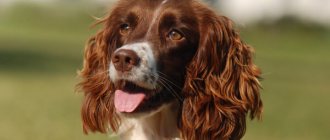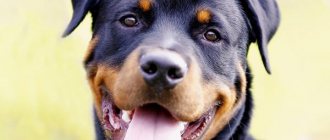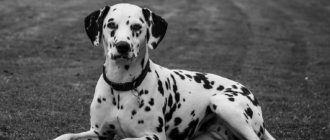Having a dog means placing a selflessly loving creature next to you, and this is already a sufficient reason for acquiring a four-legged friend.
But if you want your new friend to be something unusual, then perhaps you will like the dwarf French bulldog.
After all, its exoticism is manifested even in the name, in which the word “French”, oddly enough, does not at all indicate the place of origin of this breed.
Despite the fact that the bulldog is called “French,” its homeland is not the country of croissants.
History and description of the breed
It is believed that the French bulldog breed was bred in England by crossing English bulldogs, namely, their smaller representatives - toy bulldogs with Alans, Spanish bulldogs, now defunct, as well as pugs and terriers .
The breed resulting from these experiments appealed only to representatives of the working class. During the period of the scientific and technological revolution, many proletarians emigrated to France in search of work and, of course, took their favorites with them.
There, French aristocrats noticed unusual animals, thanks to which the dog became very popular in elite circles.
The breed became widespread in France, where it was first registered and got its name..
The French bulldog is already a decorative breed in itself, but breeders did not stop and were able to produce a smaller copy of it.
The Frenchman's blood contains the dwarfism gene, which allows him to breed mini-bulldogs.
The smallest individuals were selected from the offspring and crossed with each other until they got a representative of the ideal size . This is how the dwarf French bulldog (shown in the photo) appeared.
Owner reviews
Owners of mini French bulldogs assure that playful bullies who chase cats and chew their favorite slippers are the exception, not the rule. Usually the miniature “Frenchman” shows modesty and calmness, but always makes you fall in love with his devotion.
The popularity of the animal is explained by its charming appearance, which collects “likes” on the Internet. The need for warm clothing was perceived as a challenge and gave rise to many variations in the dog's wardrobe. Unusual costumes are a real feature of small dogs, filling the memory on their owners’ phones with their touching photographs.
Animal character
By nature, mini bulldogs are very sociable, affectionate and playful.
They become very attached to their owner, value the time spent with him, and do not tolerate separation well.
CAREFULLY!
Such decorative breeds of dogs are rarely trained and taught tricks, but for the sake of a portion of attention they are ready to master simple commands.
But it’s still better to teach lessons to kids in a playful way.
The owners will certainly be pleased with such a character trait of dwarf bulldogs as developed empathy.
The dog always feels your mood, and if there is a favorable emotional atmosphere in the house, the dog will rejoice with you. The baby will also feel your reluctance to communicate and will stay away until he is called again.
The Dwarf French Bulldog is considered an ideal pet for families with children or for retirees . By nature, the dog is quite lazy and spends most of its time lying down.
Therefore, it is not very suitable for people leading an active lifestyle.
Frenchies certainly need a little physical activity to prevent obesity, but too much exercise can be dangerous to their health.
Training
It is necessary to start training the puppy from the first days he is in the house of the new owner. From infancy, he needs to get used to the rules of behavior and understand about permissions and prohibitions. Once the puppy is comfortable in the house, it’s time to start training.
Basic positions of education:
- after all vaccinations have been completed and the puppy has been in quarantine at home for about two weeks, classes can begin on the first walk outside or at home;
- at 2 months it is quite acceptable to train a puppy to use the toilet in a diaper;
- at the same age, you can accustom a puppy to a leash and collar at home, so that by the time he goes outside for the first time, these attributes are commonplace;
- it is important to initially teach the puppy to play with his toys, and not the owner’s things;
- establish the correct daily routine and diet;
- gradually teach commands from 3 months.
What should not be allowed during the dog training process?
For the correct perception of the owner, it is not recommended:
- use incorrect intonation when giving commands;
- treats the dog rudely and uses physical punishment;
- give commands several times in a row and in different variations of pronunciation;
- conduct classes when you don’t understand the dog’s mood;
- cause the dog to become overtired;
- withhold rewards for following commands;
- conduct classes too rarely, without systematicity;
- postpone punishment until later;
- inflate demands;
- conduct classes in only one location.
Advantages and disadvantages
The dwarf French bulldog cannot be called an unpretentious dog, which is the main disadvantage of this breed.
But the positive characteristics of this breed are more significant than the negative ones.
pros:
- They don’t need a lot of space; you can live with such dogs in a small apartment;
- It will not cause you any trouble with its barking or howling, since this breed is practically silent;
- Mini French Bulldogs are very kind creatures and get along easily with children and other animals;
- Like larger representatives, this breed is distinguished by its intelligence and good learning ability, which means it is easy to train;
- The baby has short fur, which does not have an unpleasant “dog” smell and does not require special care.
Minuses:
- Susceptible to temperature changes, drafts and sudden gusts of wind;
- They are afraid of water. It is very difficult to teach them to swim and even just to bathe them;
- They do not tolerate water procedures well, but there is a need for them. Diaper rash appears in the folds of the baby's skin, so it is necessary to regularly clean them and take special care;
- Due to its anatomical features, the animal can snore worse than a human;
- When feeding, you need to adhere to a certain diet, since this breed is prone to allergies.
Poodle appearance
General impression
What does a poodle look like? Despite the fact that there are several types of poodles (different in both color and size), the breed standard is the same for all of them.
Head
The poodle's head is characterized by proportionality to the body. Looks moderately sophisticated. The skull is oval. Moderate expression of the brow ridges and feet are characteristic of a dog's muzzle. Flat, widening ears reach down to slightly pronounced cheekbones. The robust-looking muzzle is straight.
Almond-shaped eyes slightly squint, showing all the emotions of the pet. Eye colors from black to light brown are allowed (depending on the color of the dog, as well as the color of the edge of the eyelids). The small nose can be black or brown, depending on the coat color of the animal. The nostrils are well open. The colors of the narrow lips are the same as those of the nose. The upper lip overlaps the lower lip. Poodles have a scissor bite.
Neck
The neck is proportional, moderately long (slightly less than the length of the head): allows the dog to proudly hold its head. The presence of a suspension is unacceptable.
Torso
Proportion and elegance are characteristic of the curly body, this is noticeable in the photo of the poodle. The length of the body is slightly greater than the height. Normally pronounced withers, a strong back, and a rounded croup are characteristic of a poodle. The chest, which reaches the elbows, is quite wide, especially in the area of the short back. The stomach is pulled in. The body is muscular.
Forelegs
Straight, muscular legs standing parallel with oblique shoulder blades, equally long shoulders and wrists. The bones are strong. The oval feet are relatively small, the toes form a lump. The color of the pads and claws depends on the color of the dog's coat.
Hind limbs
Paws set parallel to each other with strong but not massive thighs, good stifle angle and sufficient definition of the hock joint. The metatarsals are short. The characteristics of the oval paws are the same as those of the forelimbs. The hind limbs are much more muscular than the forelimbs.
Tail
The high-set tail tapers from base to tip. It can be either long or short. A calm dog lowers its tail down, an excited dog curls it over its back.
Movement
Lightness, ease, some relaxation and importance are observed in the gait of the poodle. Having started running, the dog springs moderately, which shows the muscularity of the hind limbs.
Wool
Thick, lush hair is wrapped in spiral curls (the wool is dense, elastic; the curls are well defined, their length is more than 20 cm) or cord curls (characterized by the thinness and delicacy of the hair; the minimum length of the cord is 20 cm) - a distinctive feature of poodles. Frizzy hair on the forehead can be cut off or tied into a ponytail.
Color
The poodle's coat is evenly colored, tan marks or any other inclusions of mixtures of different shades are acceptable. There are five types of poodle colors: black, brown, grey, red or apricot. The undertone can be either cold or warm. The pigmentation of the eyelids, nose, claws, and paw pads should be dark.
Pet Features
Representatives of the dwarf French bulldog have a height (at the withers) of no more than 28 centimeters, and their weight does not exceed 8 kilograms.
The coat color is mostly white with brown spots. Many breeders charge high prices for rare blue puppies. As for their overall appearance, they are dogs with a massive head, a short blunt muzzle and unusual ears.
NOTE!
Interestingly, the breed standards suggested ears in the shape of rose petals, but American dog breeders bred the breed with ears like a bat.
Variety parameters
Some French Bulldog standards differ depending on the gender of the animal.
Dimensions and weight
The average weight of an adult male is 10-15 kg, females - 8-12 kg. The height of a male does not exceed 30-35 cm, females 25-30 cm.
Head
The mini bulldog has a wide and square head, which is why it is characterized by an overbite. Some puppies initially have an elongated or cleft palate.
The erect ears are large and rounded at the ends. The nose is short and flattened.
The jaws are well developed, but do not protrude. The lower incisors should not be behind the upper ones; this part is rounded. The jaws have no lateral displacement or distortion.
The dwarf bulldog has a wide head
Body and paws
The bulldog's body has a strong structure and a square build. The hindquarters and back are strong and muscular. The front legs are shorter than the hind legs, which makes the dog visually appear slightly stooped.
Differences from the standard French Bulldog
Mini-bulldogs differ in appearance from their larger counterparts in size and muscle development. But their temperaments are completely different.
The French Bulldog is a typical small fighting dog..
She is agile, strong, with good reactions and can be aggressive towards other animals, and you can often hear loud barking in the house.
Read more about classic French bulldogs here.
While the quiet dwarf bulldog can, at most, show the nature of a domestic cat and catch some rodent.
Also, the life expectancy of “kids” is slightly shorter.
Choosing the gender of the puppy
Before choosing a particular puppy, you need to decide on the desired gender of your pet. Male French Bulldogs are usually larger and somewhat more powerful than females of this breed . Such dogs look more advantageous at exhibition shows.
Also, the advantages of a male dog include the absence of estrus, and, accordingly, the problems that cause regular or false pregnancy and childbirth. The main disadvantage of a male French bulldog is the frequent attempts to run away from his owner after a female in heat during a walk. Among other things, male dogs often and abundantly mark their territory, and are also capable of showing unexpected unmotivated aggression if there is a potential rival in the immediate vicinity.
This is interesting! As a rule, French bulldog females are an order of magnitude more expensive than males of this breed, and if the animal is not intended to be actively used in breeding, then it is advisable to give preference to males.
Bitches of the French Bulldog breed are more affectionate, and also strongly attached to their owner and everyone in the household. Such a pet is more willing to learn during training and the education process, and almost never tries to dominate. However, the owner of a bitch will have to face some problems, including periodic heats, as well as pregnancy, childbirth and nursing puppies.
Life expectancy and health
On average, dwarf French bulldogs live from 10 to 12 years.
This already short period can be shortened if improper care is taken and diseases to which the bulldog is susceptible are ignored.
Thus, the following diseases pose a danger :
- Degenerative destruction or deformation of intervertebral discs.
- The presence of a (wedge-shaped) underdeveloped vertebra, which leads to a number of risks. Such as hernia and dislocation of the spine.
- Conjunctivitis.
- The French Bulldog has bulging eyes, this feature leads to very unpleasant consequences. For example, eyeball loss.
- Inflammation of the third eyelid.
- Entropion (entropion) or drooping third eyelid. This happens rarely and can be eliminated with surgery. The dropped eyelid is simply sutured.
- If the structure of the respiratory sinuses is incorrect, the dog’s life is threatened by such a phenomenon as brachycephalic breathing. It is expressed by attacks of suffocation. You can recognize them by the behavior of the dog. During attacks, the dog sniffs heavily, opens his mouth, bends over, throws back his head, and coughs. In this case, you must be prepared to provide first aid to the bulldog.
- Blockage of the larynx - occurs against the background of suffocation when the dog tries to grab air. The dog definitely needs emergency veterinary care. Before the doctor arrives or to the doctor, while the dog is in an acute condition, he needs to be calmed down and held in an elongated position.
- Urolithiasis disease.
- Atopic dermatitis is an allergy to one or more substances in the environment.
- Food allergies.
- Dermatitis and inflammation of the folds on the face. Occurs due to poor quality care. If your dog's face is not cleaned after eating, it will become a haven for bacteria and germs.
- Pododermatitis (bacterial) is an inflammation of the skin on the paw pads.
- Alopenia and hypotrichosis - both diseases threaten hair loss, that is, baldness.
- It is also worth knowing that female dwarf French bulldogs have quite a difficult time giving birth.
Breeders' advice
Choosing a French bulldog puppy is quite difficult for a non-professional, which is due to many breed characteristics of such a dog . The puppy's nose should be moist and black, but spotting is also allowed, which should completely disappear after five months. A completely healthy dog has a clean and free anal area.
When examining a puppy, be sure to look into its mouth. The teeth should not only be strong, but also even, with a characteristic overbite of the breed. Male dogs must be tested for cryptorchidism, and puppies at one and a half months old must have both testicles descended into the scrotum. You should also pay attention to the behavioral characteristics of the puppy. He should be active and non-cowardly, but not at all aggressive.
Content Features
French bulldogs are prone to obesity, so a special approach is needed to selecting a suitable diet. Nutrition should be balanced.
IMPORTANT!
The bulldog's weight must be constantly monitored and only with the help of high-quality scales.
Such measures will help avoid the threat of obesity itself and food allergies. You can also insure your pet against inflammation of the folds on the face; for this you need to feed the dog dry food.
To ensure that the health of your mini bulldog does not cause you any trouble, you must follow preventive measures and regularly examine it.:
- Eyes. If necessary, wipe them with a special solution or use drops;
- Nose. Signs of any dog's health include a clean, moist nose;
- Ears. They must be cleaned of plaque every day;
- Teeth;
- Joints. You should always palpate them for swelling and hematomas.
- Skin. Here it is necessary to simply check whether the baby has fleas or ticks.
Your bulldog should not be subjected to severe physical activity..
Toy French Bulldogs are not very hardy, and due to the structure of their nose, they can have breathing problems.
You should always make sure that your pet stays away from bodies of water; these dogs, as a rule, do not know how to swim.
This is no longer due to their laziness or endurance, but simply to the fact that the large head pulls the animal to the bottom. It is not uncommon for the French to catch a cold.
Therefore, in cold seasons, you need to take care of buying warm clothes for your pet.
Nutrition
What is the best way to feed such a pet:
- In its “infancy” (up to one month), the dog feeds on its mother’s milk. You can also give him goat milk. Meals 6 times a day.
- At the age of one to three months, you can already feed them with porridge. 5 times a day.
- A puppy between three and four months old should be fed 4 times a day. And you need to add soft bones to your diet.
- From four to six months, give food 3 or 4 times a day. An adult should not eat more than twice a day. This is achieved from early “childhood”. Gradually add meat products.
- From six to ten months, strictly 3 times a day.
- After 10 months, it is time to switch to two meals a day.
Do not forget that your pet should always have access to water. And leftover food needs to be removed if the dog doesn’t finish eating in 10-20 minutes.
The easiest option is to give dry food or canned dog food. The appropriate doses are indicated directly on the packaging. But food prepared by the owner will be healthier.
How to choose?
You can only purchase a mini bulldog from trusted breeders.
Since undernourished, weak and sick representatives of standard size are often passed off as dwarf Frenchies.
But even when you come to a trusted nursery, you need to know what questions to ask. Find out about the puppy's pedigree, the conditions in which it was kept, what care it was given, how and what it was fed.
A healthy puppy can also be distinguished by external signs, namely:
- Shiny fur, clean skin, the presence of a small layer of fat;
- The ears are clean, without unpleasant odors or discharge;
- The inner cavity of the mouth is pink;
- Teeth with an even and strong bite;
- Smooth paws that allow you to move easily with coordinated movements.
Choosing a puppy class
Any litter obtained even from a pair represented by the most super-elite champions contains puppies belonging to two and sometimes three classes:
- “pet class” puppies meet breed standards in basic respects, but may have some defects that do not affect the health of the animal. As a rule, such defects are represented by incorrect color or quality of coat, cryptorchidism, incorrect color of the nose or lips, as well as incorrect bite. All puppies of this class, received from a pair of purebred parents, are subject to mandatory certification, after which they receive the note “not for breeding” in the puppy card;
- “breeding class” puppies correspond to the characteristics of the breed and do not have any defects, therefore they are the main stock of dogs that participate in breeding. As a rule, this class includes females with exhibition ratings of “good” and above, as well as males with exhibition ratings of “excellent”. Animals of breeding class often produce offspring belonging to the categories of “show class” and “top show class”;
- “show class” and “top show class” puppies are the best representatives of the breed, which combine excellent breed characteristics in their exterior. Such puppies are the real pride of any breeder, the so-called “face” of the kennel at exhibition shows. They become prize-winners of special breed exhibitions, so they are deservedly the elite of this breed.
This is interesting! As practice shows, assessing the class of a puppy at a very early age is not very advisable, since some important characteristics of class can manifest themselves at a fairly mature age of the animal.
Appearance
The photo shows an adult English bulldog.
These are medium-sized dogs, but in general, their parameters are far from small. The weight of dogs depends on their age.
| Age | Weight standards, kg |
| 1 month | 2,3 |
| 3-5 months | 6,8-13,6 |
| Grown up boy | 23,6-24,9 |
| Grown up girl | 21,8-22,7 |
— Advertising —
You will have to feed puppies more often than adults. They need good nutrition due to their growth and the need to develop bone mass. Bulldogs are considered adults when they reach 18 months.
The animals are not tall, compared to other dogs. Girls and boys grow up to 31–40 centimeters in height. That's why they look short and bulky.
The dog can be of different colors and color combinations, the most common shades are:
- White
- Ginger
- Pale yellow
- brindle
- Red
- Yellow.
A dog can be “smoot” in color when its body is monochromatic and its muzzle is black. The body may contain combinations of two or three of the above colors, as well as many spots.
Briefly about the main thing
- Bulldogs are a large group of dogs, which includes about 10 officially recognized breeds.
- These are active, good-natured dogs that can fend for themselves.
- Some breeds are rare or have already disappeared.
- Bulldogs have a large head and short airways.
- It is recommended to feed dogs natural food - the structure of the muzzle can lead to swallowing food and poor digestion.
What kind of bulldogs do you like? Do you have a pet from this breed group? Would you recommend others to get this breed? Share your opinion, please.
